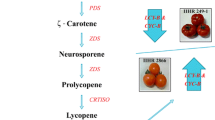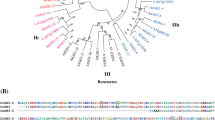Abstract
Significant progress has been made in understanding carotenoid biosynthesis in tomato (Solanum lycopersicum), and most pathway genes have been cloned and characterized. However, isolation and characterization of novel fruit ripening mutants is a continuous and essential process. This study describes the characterization of the Tan406 (Tangerine406) mutant of Solanum lycopersicum. Fruits of Tan406-mutant plants have a unique orange color and accumulate prolycopene instead of lycopene. Genetic analysis revealed that a monogenic recessive mutation affects fruit pigmentation in the mutant, which inhibits the conversion of prolycopene to lycopene. Further, molecular analysis indicates that fruit phenotype is attributed to loss of CRTISO gene function, which encodes a carotenoid isomerase enzyme that converts prolycopene to lycopene. The loss of gene function is due to the deletion of 406 bp from the CRTISO promoter region. Analysis of genome-wide transcriptome expression profiling identified several hundreds of differentially expressed genes in the fruit ripening stages. The results of microarray studies showed a tendency for upregulation of the genes at the mature green stage and downregulation at the fully ripened stage in the mutant. The isolated mutant can be used for the development of varieties having altered nutritional value.




Similar content being viewed by others
References
Alba R, Payton P, Fei Z, et al. 2005 Transcriptome and selected metabolite analyses reveal multiple points of ethylene control during tomato fruit development. Plant Cell 17 2954–2965
Alseekh S, Tohge T, Wendenberg R, et al. 2015 Identification and mode of inheritance of quantitative trait loci for secondary metabolite abundance in tomato. Plant Cell 27 485–512
Bartley GE, Scolnik PA and Beyer P 1999 Two Arabidopsis thaliana carotene desaturases, phytoene desaturase and ζ-carotene desaturase, expressed in Escherichia coli, catalyze a poly-cis pathway to yield pro-lycopene. Eur. J. Chem. 259 396–403
Bendich A 1993 Biological functions of dietary carotenoids. Ann. NY Acad. Sci. 691 61–67
Borghesi E, Ferrante A, Gordillo B, et al. 2016 Comparative physiology during ripening in tomato rich-anthocyanins fruits. Plant Growth Regul. 80 207–214
Burri BJ, Chapman MH, Neidlinger TR, et al. 2009 Tangerine tomatoes increase total and tetra-cis-lycopene isomer concentrations more than red tomatoes in healthy adult humans. Int. J. Food Sci. 60 1–16
Basha PO, Sudarsanam G, Murthy JM, et al. 2017 A low cost and efficient method of genomic DNA extraction from tomato (Solanum lycopersicum). Int. J. Recent Sci. Res. 8 22747–22750
Carrari F and Fernie AR 2006 Metabolic regulation underlying tomato fruit development. J. Exp. Bot. 57 1883–1897
Chen X, Zhang Z, Liu D, et al. 2010 Squamosa promoter-binding protein-like transcription factors: Star players for plant growth and development. J. Integr. Plant Biol. 52 946–951
Clough JM and Pattenden G 1979 Naturally occurring poly-cis carotenoids. Stereochemistry of poly-cis lycopene and its congeners in ‘tangerine’tomato fruits. J. Chem. Soc. Chem. Commun. 1979 616–619
Cooperstone JL, Ralston RA, Riedl KM, et al. 2013 Increased carotenoid bioavailability from a unique, cislycopene containing tangerine-type tomato. FASEB J. 27 1
Cooperstone JL, Ralston RA, Riedl, et al. 2015 Enhanced bioavailability of lycopene when consumed as cis-isomers from tangerine compared to red tomato juice, a randomized, cross-over clinical trial. Mol. Nutr. Food Res. 59 658–669
D’Ambrosio C, Stigliani AL and Giorio G 2018 CRISPR/cas9 editing of carotenoid genes in tomato. Transgenic Res. 27 367–378
Fraser PD, Truesdale MR, Bird CR, et al. 1994 Carotenoid biosynthesis during tomato fruit development (evidence for tissue-specific gene expression). Plant Physiol. 105 405–413
Fray RG and Grierson D 1993 Identification and genetic analysis of normal and mutant phytoene synthase genes of tomato by sequencing, complementation and co-suppression. Plant Mol Biol. 22 589–602
Gady, AL, Hermans FW, Van de Wal MH, et al. 2009 Implementation of two high through-put techniques in a novel application: Detecting point mutations in large EMS mutated plant populations. Plant Methods 5 13
Gillaspy G, Ben-David H and Gruissem W 1993 Fruits: A developmental perspective. Plant Cell 5 1439
Giovannoni J 2001 Molecular biology of fruit maturation and ripening. Annu. Rev. Plant Biol. 52 725–749
Giovannoni JJ 2007 Fruit ripening mutants yield insights into ripening control. Curr. Opin. Plant Biol. 10 283–289
Isaacson T, Ohad I, Beyer P, et al. 2004 Analysis in vitro of the enzyme crtiso establishes a poly-cis-carotenoid biosynthesis pathway in plants. Plant Physiol. 136 4246–4255
Isaacson T, Ronen G, Zamir D, et al. 2002 Cloning of tangerine from tomato reveals a carotenoid isomerase essential for the production of β-carotene and xanthophylls in plants. Plant Cell 14 333–342
Kachanovsky DE, Filler S, Isaacson T, et al. 2012 Epistasis in tomato color mutations involves regulation of phytoene synthase 1 expression by cis-carotenoids. Proc. Natl. Acad. Sci. USA 109 19021–19026
Klee HJ and Giovannoni JJ 2011 Genetics and control of tomato fruit ripening and quality attributes. Annu. Rev. Genet. 45 41–59
Lakshmi Jayaraj K, Thulasidharan N, Antony A, et al. 2021 Targeted editing of tomato carotenoid isomerase reveals the role of 5′ UTR region in gene expression regulation. Plant Cell Rep. 40 621–635
Lewinsohn E, Sitrit Y, Bar E, et al. 2005 Not just colors—carotenoid degradation as a link between pigmentation and aroma in tomato and watermelon fruit. Trends Food Sci. Technol. 16 407–415
Matsukura C, Yamaguchi I, Inamura M, et al. 2007 Generation of gamma irradiation-induced mutant lines of the miniature tomato (Solanum lycopersicum L) cultivar micro-tom. Plant Biotechnol. 24 39–44
Minoia S, Petrozza A, D’Onofrio O, et al. 2010 A new mutant genetic resource for tomato crop improvement by TILLING technology. BMC Res. Notes 3 69
Orzaez D, Mirabel S, Wieland WH, et al. 2006 Agroinjection of tomato fruits. A tool for rapid functional analysis of transgenes directly in fruit. Plant Physiol. 140 3–11
Osorio S, Alba R, Damasceno CM, et al. 2011 Systems biology of tomato fruit development: Combined transcript, protein, and metabolite analysis of tomato transcription factor (nor, rin) and ethylene receptor (nr) mutants reveals novel regulatory interactions. Plant Physiol. 157 405–425
Park H, Kreunen SS, Cuttriss AJ, et al. 2002 Identification of the carotenoid isomerase provides insight into carotenoid biosynthesis, prolamellar body formation, and photomorphogenesis. Plant Cell 14 321–332
Pecker I, Gabbay R, Cunningham FX, et al. 1996 Cloning and characterization of the cDNA for lycopene β-cyclase from tomato reveals decrease in its expression during fruit ripening. Plant Mol. Biol. 30 807–819
Prashanth PJE, Rajesh N, Padma JG, et al. 2020 Generation of gamma irradiated mutagenized population in Solanum lycopersicum cv. Arka Vikas. Curr. Trends Biotechnol. Pharm. 14 271–278
Pulungan SI, Yano R, Okabe Y, et al. 2018 Sllax1 is required for normal leaf development mediated by balanced adaxial and abaxial pavement cell growth in tomato. Plant Cell Physiol. 59 1170–1186
Rajesh N, John P, Prashanth E, et al. 2014 Development of a mutant genetic resource of tomato Solanum lycopersicum L cv. Arka Vikas. Ann. Biol. Res. 5 1–6
Romero I, Tikunov Y and Bovy A 2011 Virus-induced gene silencing in detached tomatoes and biochemical effects of phytoene desaturase gene silencing. J. Plant Physiol. 168 1129–1135
Ronen G, Carmel-Goren L, Zamir D, et al. 2000 An alternative pathway to β-carotene formation in plant chromoplasts discovered by map-based cloning of beta and old-gold color mutations in tomato. Proc. Natl. Acad. Sci. USA 97 11102–11107
Ronen G, Cohen M, Zamir D, et al. 1999 Regulation of carotenoid biosynthesis during tomato fruit development: Expression of the gene for lycopene epsilon-cyclase is down-regulated during ripening and is elevated in the mutant delta. Plant J. 17 341–351
Saito T, Ariizumi T, Okabe Y, et al. 2011 Tomatoma: A novel tomato mutant database distributing micro-tom mutant collections. Plant Cell Physiol. 52 283–296
Seymour GB, Chapman NH, Chew BL, et al. 2013 Regulation of ripening and opportunities for control in tomato and other fruits. Plant Biotechnol. J. 11 269–278
Shinozaki Y, Nicolas P, Fernandez-Pozo N, et al. 2018 High-resolution spatiotemporal transcriptome mapping of tomato fruit development and ripening. Nat. Commun. 9 364
Tanambell H, Quek SY and Bishop KS 2019 Screening of in vitro health benefits of tangerine tomatoes. Antioxidants 8 230
Tieman DM, Harriman RW, Ramamohan G, et al. 1992 An antisense pectin methylesterase gene alters pectin chemistry and soluble solids in tomato fruit. Plant Cell 4 667–679
Till BJ, Cooper J, Tai TH, et al. 2007 Discovery of chemically induced mutations in rice by tilling. BMC Plant Biol. 7 19
Unlu NZ, Bohn T, Francis DM, et al. 2007 Lycopene from heat-induced cis-isomer-rich tomato sauce is more bioavailable than from all-trans-rich tomato sauce in human subjects. Br. J. Nutr. 98 140–146
Wang B, Wang J, Feng X, et al. 2009 Effects of 1-MCP and exogenous ethylene on fruit ripening and antioxidants in stored mango. Plant Growth Regul. 57 185–192
Watanabe S, Mizoguchi T, Aoki K, et al. 2007 Ethylmethanesulfonate (EMS) mutagenesis of Solanum lycopersicum cv. Micro-tom for large-scale mutant screens. Plant Biotechnol. J. 24 33–38
Yoo HJ, Park WJ, Lee GM, et al. 2017 Inferring the genetic determinants of fruit colors in tomato by carotenoid profiling. Molecules 22 764
Acknowledgements
This research work was supported by University Grant Commission (UGC), New Delhi, India (F. No. 42-46/2013).
Author information
Authors and Affiliations
Contributions
Conceptualization and designing of the research work, OBP; Execution of field/lab experiments and data collection, JEP, NR and JSK; analysis of data and interpretation, JEP, NR, MAN and BA; preparation of manuscript, MAN, NR and OBP.
Corresponding author
Ethics declarations
Competing interest
All authors unanimously declare that we do not have any competing interest in this regard.
Additional information
Corresponding editor: Manoj Prasad
Supplementary Information
Below is the link to the electronic supplementary material.
Rights and permissions
About this article
Cite this article
Prashanth, P.J.E., Rajesh, N., Nandini, M.A. et al. Characterization of prolycopene-accumulated Tan406 mutant of Solanum lycopersicum. J Biosci 48, 52 (2023). https://doi.org/10.1007/s12038-023-00389-5
Received:
Accepted:
Published:
DOI: https://doi.org/10.1007/s12038-023-00389-5




